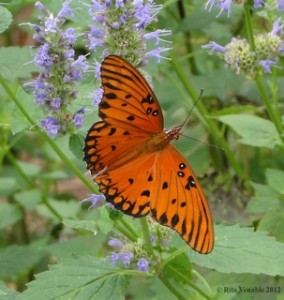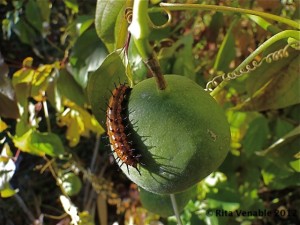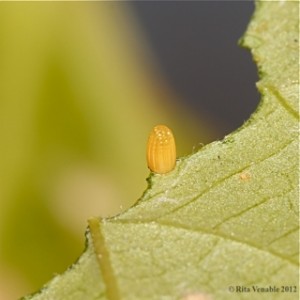Only a few Gulf Fritillary adults are still flying in Tennessee into November—their normal flight period being May 15–Nov 30 here. Most nectaring plants have died back already, so what are adults feeding on, if anything? Gulf Fritillaries spend winters in warmer climates, migrating north in spring, south in fall, but there are always a few adults that remain behind here possibly emerging after others have left. I have not seen mating this late but recently found a egg and some very small caterpillars on November 22 suggesting that females are still laying eggs here.

Although we have had several nights recently in Middle Tennessee when temperatures dipped into the 20s, passionvine is still green in places and there are still caterpillars feeding on it. Also, there are some chrysalises hanging from the eaves on the front of our house and other structures, but I don’t know if they are alive or not.
According to observations by Andrei Sourakov detailed in the Journal of the Lepidopterists’ Society (http://peabody.research.yale.edu/jls/pdfs/2000s/2009/2009-63-2-127.pdf) Gulf Fritillary caterpillars and chrysalises may become dormant (diapause) in winter in north central Florida and caterpillars may survive without food for a period of at least 4 months. Some adults emerged on warm days in January and some chrysalises survived hard freezes. According to National Climatic Data Center, the average low temperature for his north central Florida area in January of 2008 was 66.2 degrees F. The average low for Franklin, Tennessee in January of 2011 was 31.7 degrees F. —over 30 degrees difference. As far as I know, there have not been any reported sightings of Gulf Fritillaries in Tennessee in January.
November, however, is a different story. In 2011, the Franklin minimum average temperature for November was above freezing at 39.4 degrees F. It will be interesting to see what the minimum average temperature for November of 2012 is and if some of the group of caterpillars in the yard can survive. The temperature data may not appear online for another 6 months, so it is important to keep photo records and notes.

There may be other factors involved in winter survival such as the role of predation, daily high temperature averages, the combination of high temperatures and low temperatures, and the number of successional days of low temperatures. What is the cold tolerance of the adults? What is the cold tolerance of the caterpillars? What is the cold tolerance of the hostplant? What part, if any, does microclimate and sunshine have on survival of the caterpillars?
Small discoveries always pose new questions and now that the National Climatic Data Center has put weather information online for free, we have new tools to help us ask more questions! So, stayed tuned, but in the meantime, keep looking for Gulf Fritillaries!
©Rita Venable 2012
